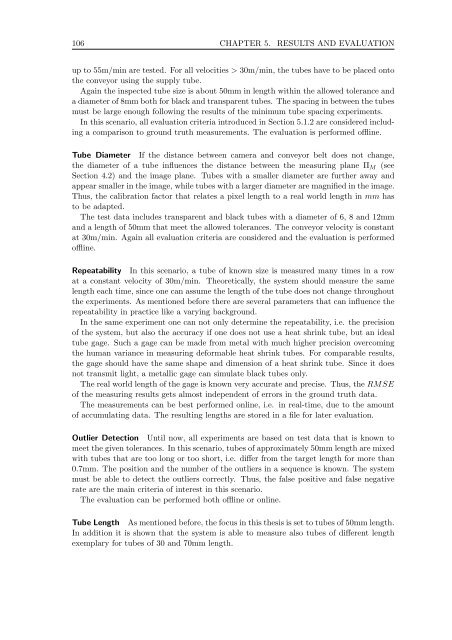Master Thesis - Fachbereich Informatik
Master Thesis - Fachbereich Informatik
Master Thesis - Fachbereich Informatik
Create successful ePaper yourself
Turn your PDF publications into a flip-book with our unique Google optimized e-Paper software.
106 CHAPTER 5. RESULTS AND EVALUATION<br />
up to 55m/min are tested. For all velocities > 30m/min,thetubeshavetobeplacedonto<br />
the conveyor using the supply tube.<br />
Again the inspected tube size is about 50mm in length within the allowed tolerance and<br />
a diameter of 8mm both for black and transparent tubes. The spacing in between the tubes<br />
must be large enough following the results of the minimum tube spacing experiments.<br />
In this scenario, all evaluation criteria introduced in Section 5.1.2 are considered including<br />
a comparison to ground truth measurements. The evaluation is performed offline.<br />
Tube Diameter If the distance between camera and conveyor belt does not change,<br />
the diameter of a tube influences the distance between the measuring plane ΠM (see<br />
Section 4.2) and the image plane. Tubes with a smaller diameter are further away and<br />
appear smaller in the image, while tubes with a larger diameter are magnified in the image.<br />
Thus, the calibration factor that relates a pixel length to a real world length in mm has<br />
to be adapted.<br />
The test data includes transparent and black tubes with a diameter of 6, 8 and 12mm<br />
and a length of 50mm that meet the allowed tolerances. The conveyor velocity is constant<br />
at 30m/min. Again all evaluation criteria are considered and the evaluation is performed<br />
offline.<br />
Repeatability In this scenario, a tube of known size is measured many times in a row<br />
at a constant velocity of 30m/min. Theoretically, the system should measure the same<br />
length each time, since one can assume the length of the tube does not change throughout<br />
the experiments. As mentioned before there are several parameters that can influence the<br />
repeatability in practice like a varying background.<br />
In the same experiment one can not only determine the repeatability, i.e. the precision<br />
of the system, but also the accuracy if one does not use a heat shrink tube, but an ideal<br />
tube gage. Such a gage can be made from metal with much higher precision overcoming<br />
the human variance in measuring deformable heat shrink tubes. For comparable results,<br />
the gage should have the same shape and dimension of a heat shrink tube. Since it does<br />
not transmit light, a metallic gage can simulate black tubes only.<br />
The real world length of the gage is known very accurate and precise. Thus, the RMSE<br />
of the measuring results gets almost independent of errors in the ground truth data.<br />
The measurements can be best performed online, i.e. in real-time, due to the amount<br />
of accumulating data. The resulting lengths are stored in a file for later evaluation.<br />
Outlier Detection Until now, all experiments are based on test data that is known to<br />
meet the given tolerances. In this scenario, tubes of approximately 50mm length are mixed<br />
with tubes that are too long or too short, i.e. differ from the target length for more than<br />
0.7mm.Thepositionandthenumberoftheoutliersinasequenceisknown.Thesystem<br />
must be able to detect the outliers correctly. Thus, the false positive and false negative<br />
rate are the main criteria of interest in this scenario.<br />
The evaluation can be performed both offline or online.<br />
Tube Length As mentioned before, the focus in this thesis is set to tubes of 50mm length.<br />
In addition it is shown that the system is able to measure also tubes of different length<br />
exemplary for tubes of 30 and 70mm length.














